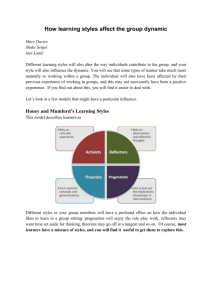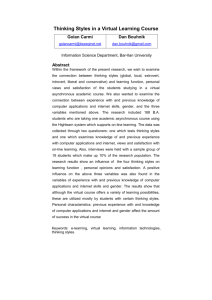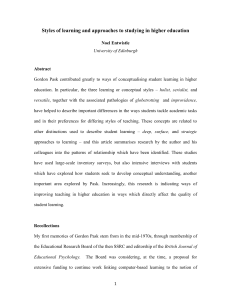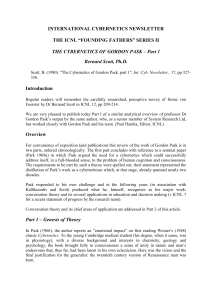Learning Theories & Teaching Metaphors: A Module Reading
advertisement
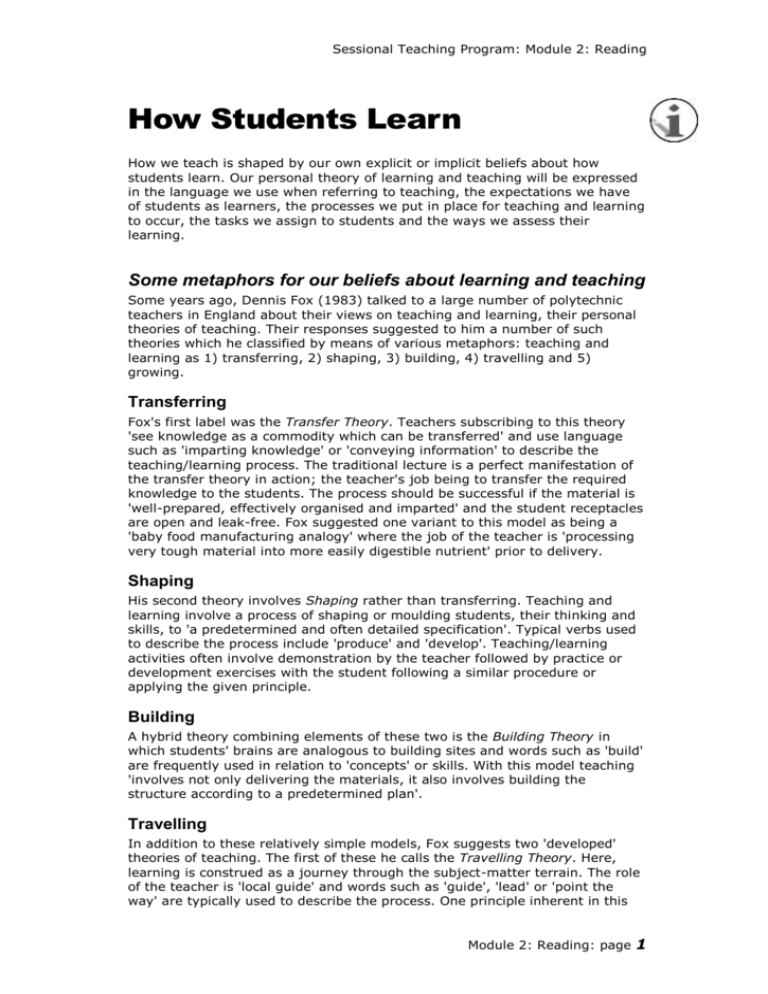
Sessional Teaching Program: Module 2: Reading How Students Learn How we teach is shaped by our own explicit or implicit beliefs about how students learn. Our personal theory of learning and teaching will be expressed in the language we use when referring to teaching, the expectations we have of students as learners, the processes we put in place for teaching and learning to occur, the tasks we assign to students and the ways we assess their learning. Some metaphors for our beliefs about learning and teaching Some years ago, Dennis Fox (1983) talked to a large number of polytechnic teachers in England about their views on teaching and learning, their personal theories of teaching. Their responses suggested to him a number of such theories which he classified by means of various metaphors: teaching and learning as 1) transferring, 2) shaping, 3) building, 4) travelling and 5) growing. Transferring Fox's first label was the Transfer Theory. Teachers subscribing to this theory 'see knowledge as a commodity which can be transferred' and use language such as 'imparting knowledge' or 'conveying information' to describe the teaching/learning process. The traditional lecture is a perfect manifestation of the transfer theory in action; the teacher's job being to transfer the required knowledge to the students. The process should be successful if the material is 'well-prepared, effectively organised and imparted' and the student receptacles are open and leak-free. Fox suggested one variant to this model as being a 'baby food manufacturing analogy' where the job of the teacher is 'processing very tough material into more easily digestible nutrient' prior to delivery. Shaping His second theory involves Shaping rather than transferring. Teaching and learning involve a process of shaping or moulding students, their thinking and skills, to 'a predetermined and often detailed specification'. Typical verbs used to describe the process include 'produce' and 'develop'. Teaching/learning activities often involve demonstration by the teacher followed by practice or development exercises with the student following a similar procedure or applying the given principle. Building A hybrid theory combining elements of these two is the Building Theory in which students' brains are analogous to building sites and words such as 'build' are frequently used in relation to 'concepts' or skills. With this model teaching 'involves not only delivering the materials, it also involves building the structure according to a predetermined plan'. Travelling In addition to these relatively simple models, Fox suggests two 'developed' theories of teaching. The first of these he calls the Travelling Theory. Here, learning is construed as a journey through the subject-matter terrain. The role of the teacher is 'local guide' and words such as 'guide', 'lead' or 'point the way' are typically used to describe the process. One principle inherent in this Module 2: Reading: page 1 Sessional Teaching Program: Module 2: Reading model is that the guide, while expert, is still open to new discoveries, knowing that 'the countryside is continually changing and that there is always something new to learn'. Another is that however knowledgeable the guide may be, exploration is essentially a personal endeavour which learners must do themselves. Growing Fox's final model is the Growing Theory in which the student's brain is seen as a garden tended by the gardener teacher. Fox does not suggest descriptors for this model, but they would include words such as 'nurture' or 'foster development' or 'promote growth' of the student in relation to the subject. Reflect on the words you used to describe teaching and learning. Which of Fox's personal theories of teaching do your words most closely align with? Do they express teaching as essentially a process of transferring, shaping, building, journeying or gardening? Or is there some other metaphor which best fits your beliefs about teaching and learning? How is this metaphor lived out in your teaching and learning practices? Learning and Teaching metaphors (after Fox 1983) Label Words used Transferring Imparting knowledge; conveying information Shaping Produce; develop Building Build (concepts, skills) Travelling Guide, lead, point the way Growing Nurture, foster development, promote growth Some theoretical frameworks There are numerous theoretical frameworks we could draw on to try to understand how students learn and how we might best facilitate that learning. We will discuss just three of them here: 1) teaching/learning theories, 2) approaches to learning and 3) learning styles. Teaching/Learning theories The metaphor you chose to talk about your teaching and learning probably fits into one of two broad theoretical traditions: The OBJECTIVIST tradition sees knowledge as existing independently of the knower. The process of learning involves coming to know that which already exists. Teaching involves facilitating the acquisition of that knowledge. The CONSTRUCTIVIST tradition sees knowledge as being constructed by the learner, the process being a cumulative one in Module 2: Reading: page 2 Sessional Teaching Program: Module 2: Reading which learners build their own understanding by active engagement in the learning process. Which of these two traditions you align yourself with will determine the choices you make about the way you teach, the learning experiences you will set up for your students and the ways you will assess their learning. Approaches to learning One of the models commonly applied to learning in higher education was first devised by Marton and Saljo (1976) and has since been developed by them and others. The basic principle is that students bring a whole cluster of personal and experiential variables to any learning context and draw on those to implement one of three possible approaches to their learning in that context: deep, surface or strategic. The approaches are not inherent in particular individuals. Rather, they are taken on by individuals in response to the situation in which they perceive themselves. A learner’s perception may or may not, however, match with the lecturer's or tutor's perceptions. Students taking a deep approach in a particular learning situation are motivated by an intrinsic interest in the subject matter and a desire to make sense of the material and relate it to their real life experience. They are actively involved in the learning process and seek to gain some underlying meaning. The process is facilitated by participation and active engagement. A surface approach is typically associated with feelings of anxiety and low selfesteem, students being motivated by the extrinsic desire to avoid failure. Using this approach, they engage with the material at a superficial level, attempting to cram and memorise with little real understanding. A surface approach is often resorted to when students are struggling to make sense of the material in courses that involve a large amount of content and excessive workloads. Students adopting a strategic approach are motivated by a desire to achieve high grades, or deliberate decision to simply gain a pass (eg if it is a compulsory course not of their own choosing or interest). They use whatever combination of approaches they believe will best meet the requirements of the assessment tasks. Learning Approaches (after Marton and Saljo2) Approach DEEP SURFACE STRATEGIC Motivation Make sense of the material (part whole); relate it to life experience Overcome feelings of anxiety, desire to avoid failure Desire to achieve high grades Strategies Active learning approaches to gain underlying meaning Cram and memorise with little real understanding Combination of approaches that will best meet the requirements of the assessment tasks Module 2: Reading: page 3 Sessional Teaching Program: Module 2: Reading Learning styles Pask (1976) identified two major styles of learning, holist and serialist. These, unlike learning approaches, represent a more persistent orientation to learning for any one individual (even when the other style would be more appropriate for a particular learning situation). Students with a holist orientation take a broad view of the subject matter right form the start. They like to see the big picture and the overarching principles into which they progressively fit the smaller details. They move comfortably from the theoretical principles to real-life applications. The serialist builds understanding by engaging progressively with the component parts, eventually forming a picture of the whole. They prefer to deal with each component in turn before considering applications of the whole. While both styles can lead to successful learning outcomes, total reliance on either one to the exclusion of the other results in what Pask calls learning pathologies. For the holist, the pathology is globetrotting, overgeneralisation without the support of appropriate evidence or argument. For the serialist, the extreme is improvidence, a failure to move from the details to the whole, an inability to ‘see the wood for the trees’. Matches or mismatches between learner style and teacher style or between learner style and task can greatly affect learning outcomes. Learning Styles (after Pask (1976)) Orientation HOLISTIC SERIALIST Approaches & advantages see the big picture and the overarching principles into which they progressively fit the smaller details. They move comfortably from the theoretical principles to reallife applications builds understanding by engaging progressively with the component parts Disadvantages if overdone globetrotting, overgeneralisation without the support of appropriate evidence or argument improvidence, a failure to move from the details to the whole, an inability to ‘see the wood for the trees’ References Fox, D. (1983) Personal theories of teaching. Studies in Higher Education, 8(2), pp.151-163. Marton, F. & Saljo, R. (1976) On qualitative differences in learning. 1 outcomes and processes. British Journal of Educational Psychology, 46, pp.411. Pask, G. (1976). Styles and strategies of learning. British Journal of Educational Psychology, 46, pp.128-148. Module 2: Reading: page 4 Sessional Teaching Program: Module 2: Reading Further reading If you would like to read more about the issues raised in this module, you might like to check out the following: Cannon, R. & Newble, D. (2000) A handbook for teachers in universities and colleges: a guide to improving teaching methods. 4th ed. Kogan Page, London. Chapters 1 & 2. (Barr Smith Library 378.17 N534h.4) Entwistle, N. (2001) Styles of learning and approaches to studying in higher education, Kybernetes, 30(6/6), pp.593-602. Noel Entwistle draws together Marton and Saljo's approaches to learning and Pask's learning styles and considers their relevance for learning and teaching. http://www.emeraldinsight.com/Insight/ViewContentServlet?Filename=P ublished/EmeraldFullTextArticle/Pdf/0670300508.pdf Johnston, C. (n.d.) Fostering deeper learning Carol Johnston, from the Teaching and Learning Unit in the Faculty of Economics and Commerce at the University of Melbourne talks about applying learning principles (including those of Pask and Marton and Saljo) to the classroom. http://tlu.ecom.unimelb.edu.au/papers/DEEPL1.pdf Marchese, T. (2002) The new conversations about learning insights from neuroscience and anthropology, cognitive science and workplace studies. Theodore Marchese draws on recent findings from a range of discipline areas to suggest practical strategies to promote student learning. http://www.newhorizons.org/lifelong/higher_ed/marchese.htm Marton, F., Hounsell, D. & Entwistle, N. (1984) The experience of learning. Scotish Academy Press, Edinburgh. (Barr Smith Library 378.1702812 E96) Raaheim, K., Wankowski, J. & Radford, J. (1991) Helping students to learn: teaching, counselling, research. Open University Press, Buckingham. (Barr Smith Library 378.17 R111h.2) Kerry O'Regan, June 2007 © The University of Adelaide Module 2: Reading: page 5
